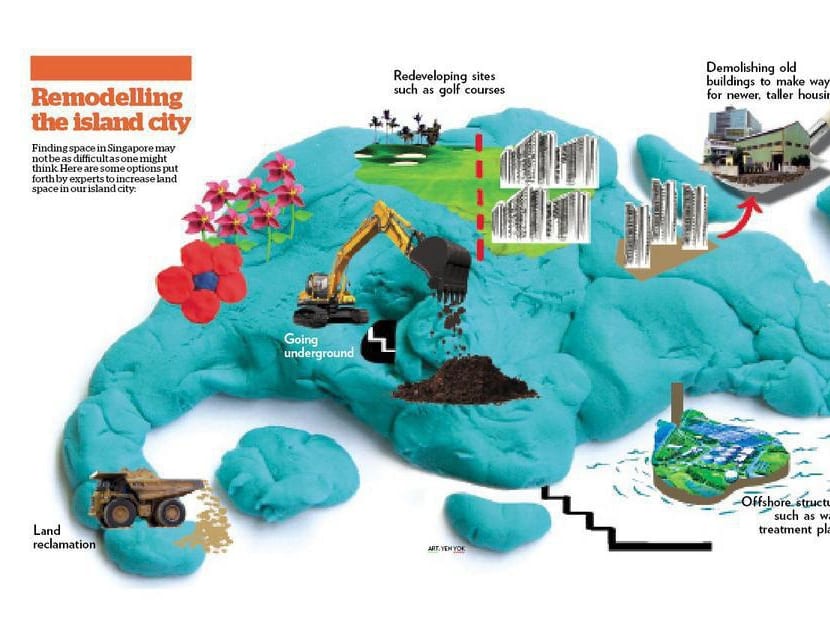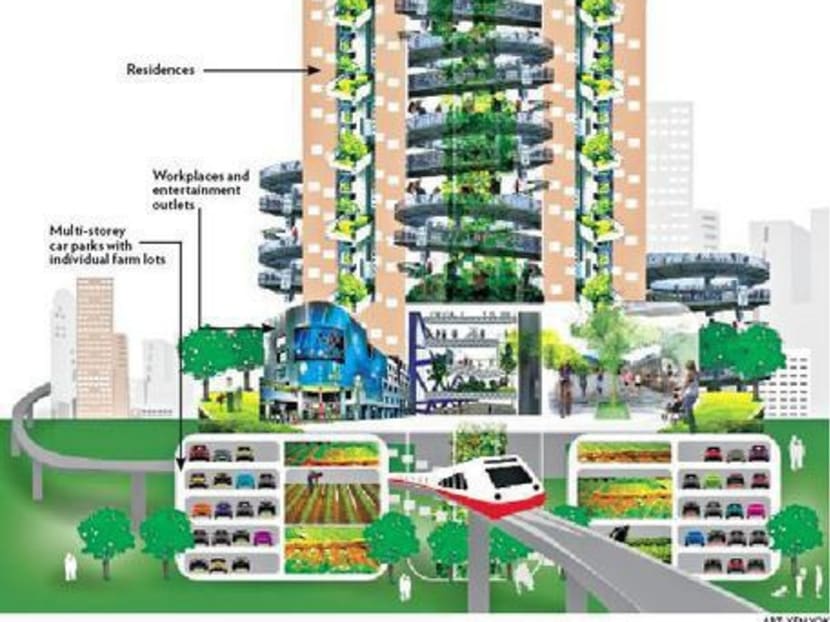Short of space? No such thing
If architect Tan Cheng Siong had his way, Singapore’s living areas would be multi-capable zones teeming with activity, sited next to MRT stations.
If architect Tan Cheng Siong had his way, Singapore’s living areas would be multi-capable zones teeming with activity, sited next to MRT stations.
People would work and live there. Workplaces and entertainment outlets would be sited below residential spaces, with the different functions vertically separated via a system of pedestrian, bicycling and landscaped decks.
Buildings would have frames built to last a long time, but with flexi-changeable interiors. They would be lush with vertical greenery and allow for vertical air circulation.
They would feature a variety of housing such as cluster homes, penthouses and apartments. They would also be equipped to collect rainwater, to produce energy via solar panels and mini-wind farms, and food via personal farm plots in multi-storey carparks.
“Citizens want affordable housing and employment, leisure and mobility, fresh air and gardens, babies and families, communities and opportunities,” said Mr Tan, principal of Archurban Architects Planners.
GEOGRAPHY NOT A LIMITATION
Mr Tan, Designer of the Year at the 2012 President’s Design Award, believes innovative design, good management and architecture that incorporates what he calls the “skyland” concept is key to successfully accommodating a larger population.
Geographical land size should not stop Singapore from multiplying its volume of space — and no, he isn’t referring to more shoebox apartments.
“Stop them before they become head shrinkers and slums,” said Mr Tan, who has previously said land shortage is a “fallacy”.
Singapore could house a population of 6.5 million to 6.9 million by 2030, according to the population White Paper published last month. The Ministry of National Development (MND) reckons that about 7 per cent more land is needed — about 766 sq km, up from 714 sq km available today — to “comfortably support” the projected population.
Areas that could be reclaimed by 2030 include Tuas Port, Pulau Tekong and Jurong Island. Beyond 2030, areas including Simpang, Marina East, Changi East, Sungei Kadut, Pasir Ris and around the Western islands could be reclaimed if needed.
RECLAIM OR RECYCLE
Experts, however, note the limits to the territorial sea space available for reclamation. There is a limit to how far Singapore can reclaim if the Republic is to keep its anchorages and fairways for the maritime and shipping industry, said civil engineering professor Yong Kwet Yew of the National University of Singapore.
He notes that shallow waters less than 20m deep have been reclaimed in the past, and current projects are in depths of between 30m and 40m. It is less economically feasible to reclaim at further depths, Prof Yong said.
Besides reclamation, the intention is to develop existing land not in use, intensify land use and “recycle” land, an MND spokesperson said. To cater to economic and population growth, more land will be required for “critical uses” like housing, community facilities, industry and infrastructure.
To this end, the Government plans to consolidate land-intensive activities such as military grounds and golf courses. The latter will be allowed to run out their leases before being redeveloped, the MND said. Land for old industrial estates will also be recycled.
GOING UNDER
Beyond these measures, exciting possibilities lie below ground and offshore. An Underground Master Plan is in the works to map out possible uses of this subterranean resource, and Prof Yong said a framework of subterranean land rights should also be created to support underground development.
He draws a distinction between spaces created at the basement of buildings — which are a vertical extension of these structures constructed in the ground, and commonly used for car parks or shopping malls — and underground caverns, which are usually standalone spaces created in the rock.
In general, underground space is suitable for uses that do not require a long stay by humans. “The lack of natural ventilation or sunlight may have psychological and behavioural effects on humans that we are still not fully aware of,” Prof Yong said.
But such spaces are suitable for pollutive or noisy uses such as roads and heavy industries, as these would require less of a land buffer underground (building noise barriers above ground can be a blight on the landscape, he noted).
Potential structures that can be housed underground include road and rail infrastructure, car parks, power stations, treatment plants, research labs, reservoirs, warehouses and even performance halls, said Prof Yong.
SUBTERRANEAN SCIENCE CITY?
Singapore is already exploiting some of its subterranean space.
Networks of tunnels channel sewage to a Changi treatment plant, and distribute electrical and telecommunications cables, district cooling and water pipes in Marina Bay.
The Defence Ministry’s Underground Ammunition Facility is built beneath a former quarry in Mandai and the Jurong Rock Caverns, an oil and petrochemical storage facility being built 130m under Jurong Island, will begin operations later this year.
The JTC is also studying the development of an underground science city beneath Kent Ridge Park.
A feasibility study on the ambitious project was completed last year by a Swiss-Singapore consortium, which came up with a design for 40 linked rock caverns with total rentable space of 192,000 square metres across three to four levels, it was reported. The caverns could house research laboratories for biotechnology and life sciences as well as data centres.
The MND added it is technically feasible to build large utilities and infrastructure facilities such as data centres, incineration and water reclamation plants underground, and it is studying whether to do so in order to “free up valuable surface land for higher value uses or community uses”.
It has also commissioned a consultancy study — to be completed by June next year — to explore innovative design and engineering solutions that could reduce the cost of large underground developments.
OVERSEAS MODELS
There is no shortage of examples of what has been done overseas — the Churchill Falls Power Station and RESO underground city in Canada, and the Itakeskus swimming complex in Finland are just a few, said Prof Yong.
And in Germany, an “innovative” underground transportation pipeline is being developed for cargo, which frees up surface infrastructure and also reduces pollution and noise caused by heavy vehicles, he said.
“When Montreal and other major cities in temperate climates develop underground cities and shopping malls, it is as much about creating space as it is about consumers’ comfort during cold winters and hot summers,” he said. “Similarly, underground shopping malls in Singapore provide comfort during hot weather and rain.”
In planning underground development, there is a need to account for unique conditions here such as the high ground water table, high humidity and variable geological formations.
Unlike some cities with more extensive cavern developments like Helsinki in Finland and Oslo in Norway, Singapore has a flatter terrain.
But preliminary studies have shown that “judicious ground improvement” of soils can render it feasible for underground caverns. “From an engineering perspective, there is no limit to how much space could be potentially exploited,” said Prof Yong. “The limit often lies in economic and commercial viability of the project.”
There is one caveat, however: Underground space, once built, is difficult to redevelop. Planning must hence be done in a sustainable manner, and spaces should be designed for permanency or with a high degree of flexibility for change in use, he said.
ALL AT SEA
What about floating structures off Singapore’s coast?
They are mobile, less damaging to the marine ecosystem than land reclamation and enable unsightly utilities like incinerators and wastewater treatment plants to be located away from the population. But they also cost more to maintain than land structures, require a good foundation for station-keeping and positioning and incur stability concerns due to waves, winds and currents, said Professor Soh Chee Kiong of the Nanyang Technological University’s School of Civil and Environmental Engineering.
The Marina Bay Floating Platform here is an example of a floating structure, as is Tokyo’s Mega-Float which serves as a runway for airplane takeoffs and landing, and a floating hotel built by Singapore’s Bethlelem shipyard now being deployed in North Korea.
Research by NUS and NTU on floating structures in the past decade have mainly targeted applications for the offshore and marine oil and gas industry — which are more challenging than, say, for floating hotels, said Prof Soh.
The National Innovation Challenge last year on Land and Liveability could spur research to develop new ideas in floating structure technology, he said.
Overseen by the National Research Foundation, the S$135 million set aside aims to create new space and optimise land use to support an economically vibrant, highly liveable and resilient city of the future.
OPPORTUNITY, NOT PROBLEM
Prof Soh reckons that, depending on how the country develops and public acceptance, Singapore’s landscape in 50 years could feature multi-purpose offshore floating structures for its airport and seaport, for solar and wind energy harvesting, for fish farming and sea sports.
“If I were a planner, I would look at using up available existing space including surrounding islands first, then go underground and if we need to, go offshore — though technology is there, research should continue to make them more durable, cost-effective and sustainable,” he said.
Urban and land use planning for a denser population is complex, but as Professor Heng Chye Kiang, Dean of the NUS School of Design and Environment put it: “The question is whether Singapore can still be as liveable as its population continues to grow ... the challenge can also become an opportunity to introduce new typologies of integrated development, more meaningful open and green spaces integrated with amenities, a more effective mobility system and better use of new technologies to render our city more efficient and resilient.”
Will HDB flats of the future be taller?
Like all other developments, HDB blocks are subject to height control based on the relevant agencies’ planning rules, flight paths and other technical requirements, said the MND.
Standing tallest at the moment is the Pinnacle@Duxton at 50 storeys. In towns with less severe height constraints — such as Toa Payoh, Queenstown, Bukit Merah — residential developments are “in the range of 40 stories”, with a few blocks under construction exceeding that.
HDB already builds to the maximum allowable height in new towns. But it does not do so in the Central Area where height limits are less restrictive, because very high-rise buildings will require high-speed lifts and an additional fire safety refuge floor — extras which will be “expensive to provide and maintain”, said MND.








